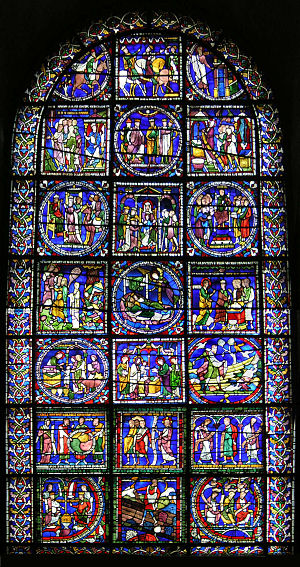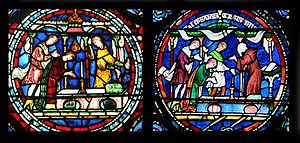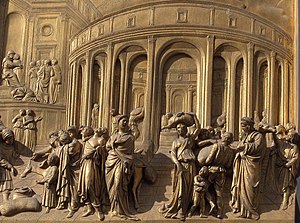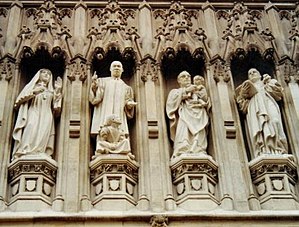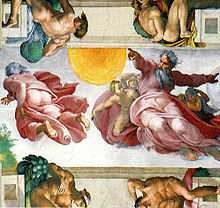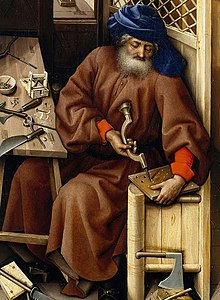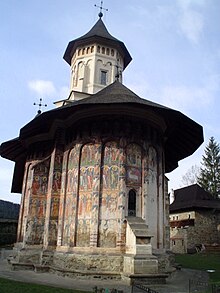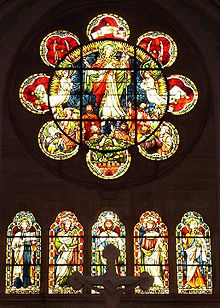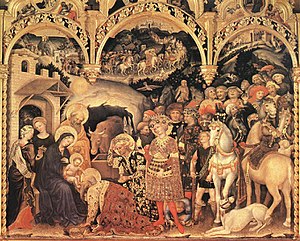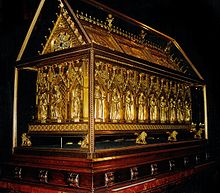Poor Man's Bible
[1] The term Poor Man's Bible is not to be confused with the so-called Biblia pauperum, which are biblical picture books, either in illuminated manuscript or printed "block-book" form.
But despite the fact that the books, at least in their earlier manuscript versions, were created for the rich, while the carvings and windows of a great church provided free entertainment and instruction to all who entered the doors, there were strong points of similarity in both subject matter and iconography.
There is, for example a particular motif of several sheep, one of which has a foot raised to scratch its ear, which occurs in Italy in the 13th and 14th centuries in manuscript illumination, wall paintings and carved stone panels.
For the Poor Man's Bible to fulfil its aim, the viewer needs to know and to accept the Christian premise that he/she is a sinful being and as such will be brought to trial on the Day of Judgement.
A church dedicated to St Francis of Assisi might focus on the miraculous moment at which the saint, while praying before a large panel crucifix, heard the voice of God and received on his hands the signs of the wounds of Christ's crucifixion, the stigmata.
But in the narrower sense it was an organization, and, particularly when under threat of heresy, humanism, division and reform, it needed to maintain and reinforce its role in offering the right way to Salvation.
It is not uncommon to see religious paintings of the Blessed Virgin enthroned with the Christ Child and surrounded by numerous saints, including some of the 1st century, and some belonging to the particular Order who commissioned the work.
The Church of St John at Tideswell in Derbyshire has a particularly fine set of 20th-century bench-ends by Advent and William Hunstone, showing the rites of Baptism, Confirmation and Ordination.
In many Protestant churches the crucifix has been replaced by a simple cross without a figure, symbolically representing both the redeeming sacrifice and the resurrection to new life offered by Jesus.
This may be related in a continuous sequence of pictures, either in paint, mosaic, wood sculpture or stained glass, and located either around the walls of a church or, particularly in French Cathedrals, in niches in a screen that surrounds the Sanctuary, so that they might be seen by people walking around the ambulatory.
There are two complete frescoed schemes in Italy, one painted by Giusto de Menabuoi in the Baptistery of the Cathedral of Padua in the 14th century and another of about the same date by Bartolo di Fredi in the Collegiate Church in San Gimignano.
By far the best known of such schemes are the one painted by Michelangelo on the Sistine Chapel ceiling and that created in bronze for the doors of the Baptistery of Florence by Lorenzo Ghiberti, the so-called "Gates of Paradise".
List of common subjects In many of the decorative schemes that illustrate the life of Jesus, the narrative is set into the context of related stories drawn from the Old Testament and sometimes from the Acts of the Apostles.
God is often depicted in the act of creation as described in Genesis[4]– making the firmament (or Earth), placing the Sun, stars and Moon in the sky or creating mankind.
Convention provided four compass points, four winds, four elements of Fire, Air, Earth and Water and four humors affecting the human nature.
Consequently, groups of four people or objects are common in Christian art, demonstrating that the Church is directly linked to the order of material and earthly things that God has put in place.
[7] Creatures such as hares, geese, monkeys, foxes, lions, camels, gryphons, unicorns, bees, and storks abound in the decorative carvings of capitals, wall arcading, ceiling bosses and the wooden fittings of cathedrals.
In one remarkable mural, in the Catacomb of the Aurelii, is the earliest image of Jesus, as he came to be commonly depicted, as a bearded, Jewish man in long robes.
Golden mosaic can be created by applying gold leaf to a single surface of a transparent glass tile, and placing the gilt inwards towards the mortar so that it is visible but cannot be scraped.
In Byzantine Italy, the application of stone reliefs of this nature spread to cathedra (bishop's thrones), ambo (reading lecterns), well heads, baldachin (canopy over altar) and other objects within the church, where it often took on symbolic form such as paired doves drinking from a chalice.
In Italy, during the Byzantine period, windows were often filled with thin slices of alabaster, which although not figurative, gave a brightly patterned effect when sunlight was transmitted through them.
The earliest known figurative stained glass panel is a small head of Christ (with many fragments missing) found in a ditch near the royal abbey of Lorsch-an-der-Bergstrasse and thought to date from the 9th century.
Because the method was very meticulous, tempera paintings are often small, and were frequently grouped into a single unit with hinged sections, known as a diptych, triptych or polyptych, depending on its number of parts.
Some large altarpiece paintings exist, particularly in Italy where, in the 13th century, Duccio di Buoninsegna, Cimabue and Giotto created the three magnificent Madonnas that now hang in the Uffizi Gallery, but were once housed in the churches of Florence.
The oldest large wooden sculpture to have survived in Europe is the painted and gilt oak Crucifix of Archbishop Gero (969-971), in Cologne Cathedral.
From the early Byzantine period there remains a number of Communion vessels, some of which, like the paten found at Antioch, have repousse decoration of religious subjects.
In the early 15th century the renowned sculptor, Donatello was commissioned to create series of figures for the chancel screen of the Basilica di Sant'Antonio in Padua.
St. Mark's Basilica of Venice houses the Pala d'Oro, an altarpiece pieced together over several hundred years so that it has elements of the Gothic and the Byzantine arts.
In the Baroque period the use of mixed media reached a high point as great altarpieces were constructed out of pietra dura and marble, wood and metal, often containing oil paintings as well.
They are often dressed in elaborate satin garments decorated with metallic braid and lace, pearls, beads and occasionally jewels and may be decked with jewelry and trinkets offered by the faithful.
